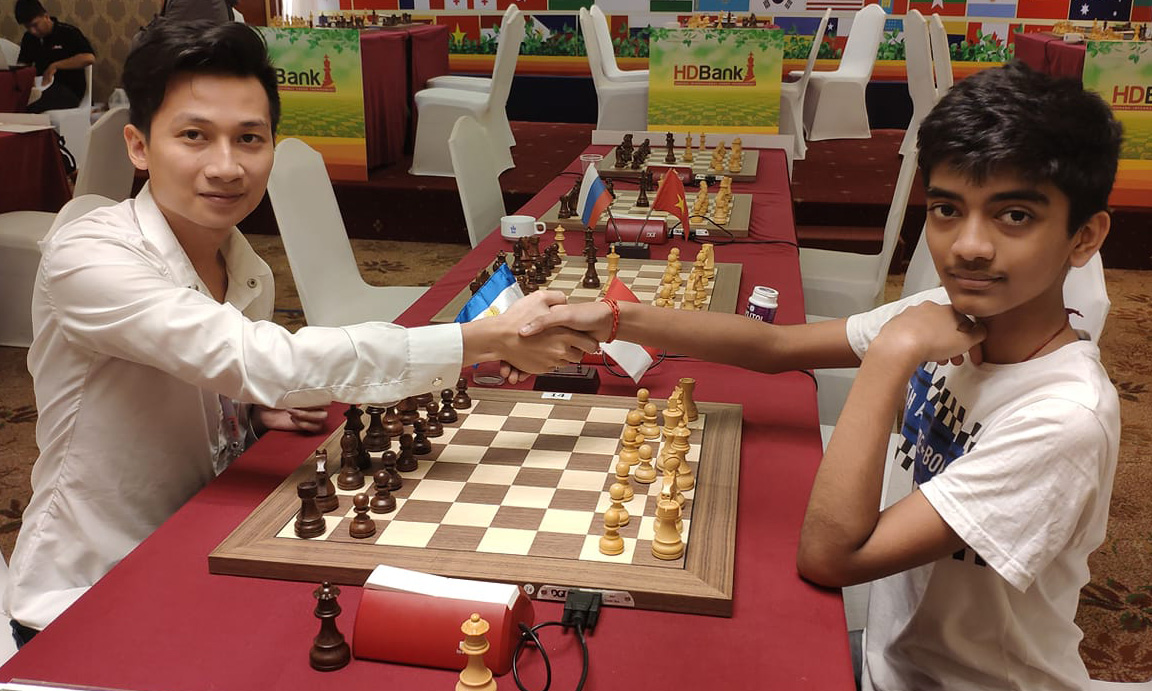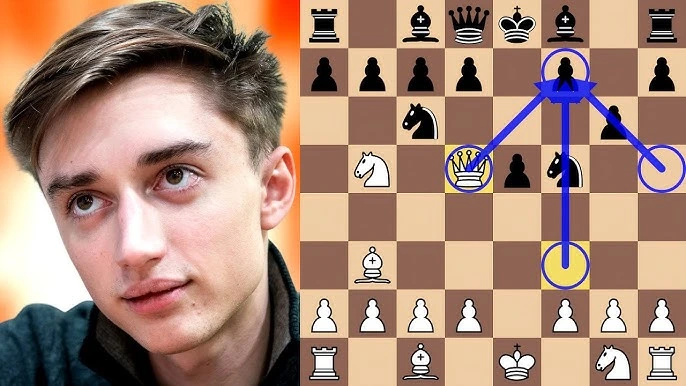When Daniil Dubov sat down to play Georg Meier at the 2025 FIDE World Cup in Goa, few could have predicted that their rapid tiebreaker would produce one of the most entertaining and chaotic battles of the tournament. After two calm classical draws and another quick split in the rapids, Dubov — ever the showman — decided to wake the crowd up with one of the wildest choices imaginable: the Frankenstein–Dracula Variation of the Vienna Game.
It’s an opening that sounds like a Halloween joke but is very real — and very dangerous. A creation of romantic-era chess minds from over a century ago, this line mixes beauty, horror, and razor-sharp tactics in equal measure. For fans of chaos on the 64 squares, it doesn’t get any cooler than this.
A Monstrous Beginning
The Frankenstein–Dracula Variation begins with familiar moves:
- e4 e5
- Nc3 Nf6
- Bc4 Nxe4
- Qh5!?
And just like that, the game is on fire.
White immediately threatens checkmate on f7, forcing Black to defend precisely with 4…Nd6 — the only move that saves the game. From there, both sides dance on a knife’s edge.
This variation gets its spooky name from its monstrous imbalance and bloodthirsty tactics. Early analysts joked that both sides would end up in pieces — like Frankenstein and Dracula tearing each other apart. In modern chess terms, it’s a test of nerves, intuition, and calculation.
Dubov Wakes the Sleeping Beast
Dubov, often called “the magician” or “the sleeping bear” for his unpredictable style, chose the Frankenstein–Dracula not out of desperation but as a statement. “You never know when he wants a draw or a win,” commentator David Howell observed. On that day, Dubov clearly wanted to win — and to do it in style.
Meier, a methodical player best known for his French Defense, was caught completely off guard. His time usage in the opening betrayed his confusion. After Dubov’s queen zigzagged from h5 to f3 to d5 — moves that might look like beginner mistakes — the position already brimmed with tactical possibilities. Every move carried threats of forks, pins, discovered checks, and sudden mates.
By move 8, engines were screaming, and spectators were grinning. This wasn’t just a chess game — it was a knife fight in a haunted house.
From Romantic Chaos to Modern Calculation
To understand the depth of this line, it’s worth remembering that the Frankenstein–Dracula Variation dates back to the year 1900, when Jacques Mieses and Amos Burn played it in a London tournament. Even then, it fascinated players for its violent imbalance: White’s queen storms forward early, while Black’s king fights for survival amid shattered pawn structures.
Fast-forward 125 years, and here was Daniil Dubov reviving it on one of the biggest stages in the chess world. And it worked — spectacularly.
After 6. Nb5 g6 7. Qf3 Nf5 8. Qd5, the position looked like a hybrid between classical beauty and modern insanity. Meier responded with 8…Nh6, and Dubov, pushing for initiative, advanced d4, a move that looked logical but, as GM Rafael Leitao later explained, was actually a subtle inaccuracy.
In his Game of the Day analysis, Leitao pointed out that 9.d3! would have kept a clear advantage: “With the pawn on d3 instead of d4, White retains control and flexibility. On d4, the center opens too soon — and Black gets counterplay.”
It was a small but profound difference, the kind of nuance that separates preparation from improvisation.
The Turning Point: 13…Bxb5!!
Despite Meier’s early stumble, he soon found one of the most beautiful defensive ideas of the entire World Cup: 13…Bxb5!!.
At first glance, the move looks suicidal — it leaves a rook hanging in the corner — but it’s the only way to stay alive. Even Leitao, annotating the game afterward, called it “an impressive find.”
At that moment, the position was a battlefield: Dubov’s pieces swarmed the kingside, Meier’s rooks were split, and both players were living on their increment. Each move was a test of imagination.
Dubov’s Magic
As the clock ticked down, Dubov’s intuition took over. He found the active 14.dxe5!, opening lines toward the black king. When Meier later blundered with 22…Qf6?, Dubov pounced immediately with 24.Qc4+!, sealing victory in dazzling style.
Agadmator, the popular YouTube chess commentator, could hardly contain his excitement:
“If someone told you that you can play queen h5, queen f3, queen d5 — all by move eight — you’d think it’s a beginner’s game. But no, it’s Daniil Dubov, one of the best players in the world!”
He compared Dubov to the great Mikhail Tal — another “magician” who could turn chaos into art.
Beauty in the Madness
So what makes the Frankenstein–Dracula so irresistibly cool?
First, the name — a perfect fit for the carnage it produces.
Second, the dynamics — both sides are in constant danger. There’s no safety, no calm, no dull maneuvering.
Third, the aesthetic — queens flying around, knights diving into enemy territory, and kings refusing to castle because the battlefield won’t allow it.
Even with modern engines, the line remains a labyrinth. One slip, and your position collapses. Play it with courage, and you might just deliver the most beautiful checkmate of your life.
Why It’s Rare — But Never Forgotten
At the top level, openings like this are a double-edged sword. One wrong move can end your tournament — but one right move can make your legend.
That’s why you rarely see Frankenstein–Dracula at elite events: the engines know too much. Objectively, after best play, the game often equalizes. But “objectively equal” doesn’t mean easy to survive — especially against someone like Dubov.
In online blitz, however, it’s alive and well. Players love it for its psychological power. Opponents either panic or burn time calculating phantom threats. For a few glorious moves, the board feels like a living creature — unpredictable, dangerous, and alive.
Dubov’s Victory and the Legacy
Dubov’s win over Meier wasn’t just another World Cup tiebreak. It was a reminder that chess, even in the age of 4000-rated engines, still has room for creativity and madness.
He took a century-old monster, revived it in 2025, and made it roar again.
After the game, Agadmator summed it up perfectly:
“It was a great fight, a great match. Dubov eliminates Meier and goes on to face Praggnanandhaa — and we get a magician versus a prodigy. What more could you ask for?”
Indeed, what more could any chess fan ask for?
The Frankenstein–Dracula Variation might never be the most practical weapon in a World Championship match. But for those who play chess not only to win but to create — to feel something over the board — it remains the coolest, most dangerous opening of them all.

I’m Xuan Binh, the founder of Attacking Chess, and the Deputy Head of Communications at the Vietnam Chess Federation (VCF). My chess.com and lichess rating is above 2300. Send me a challenge or message via Lichess. Follow me on Twitter (X) or Facebook.

